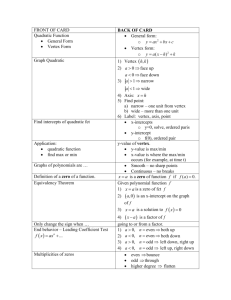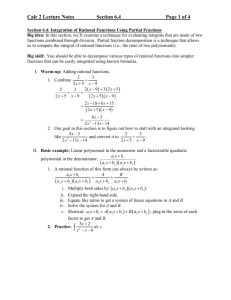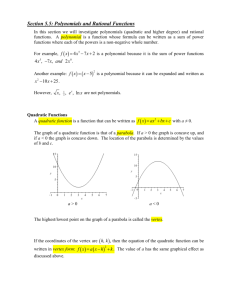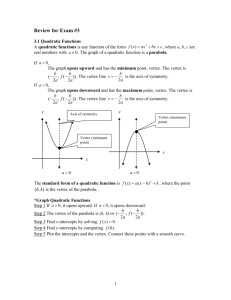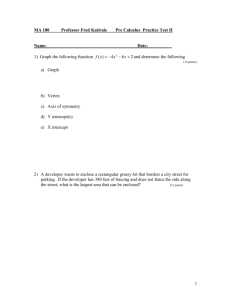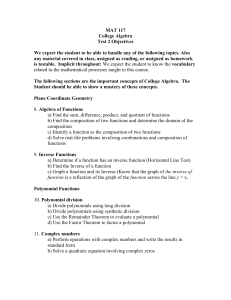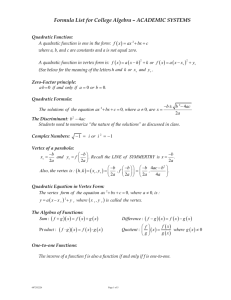Math 4 Exam 2 Guidelines
advertisement
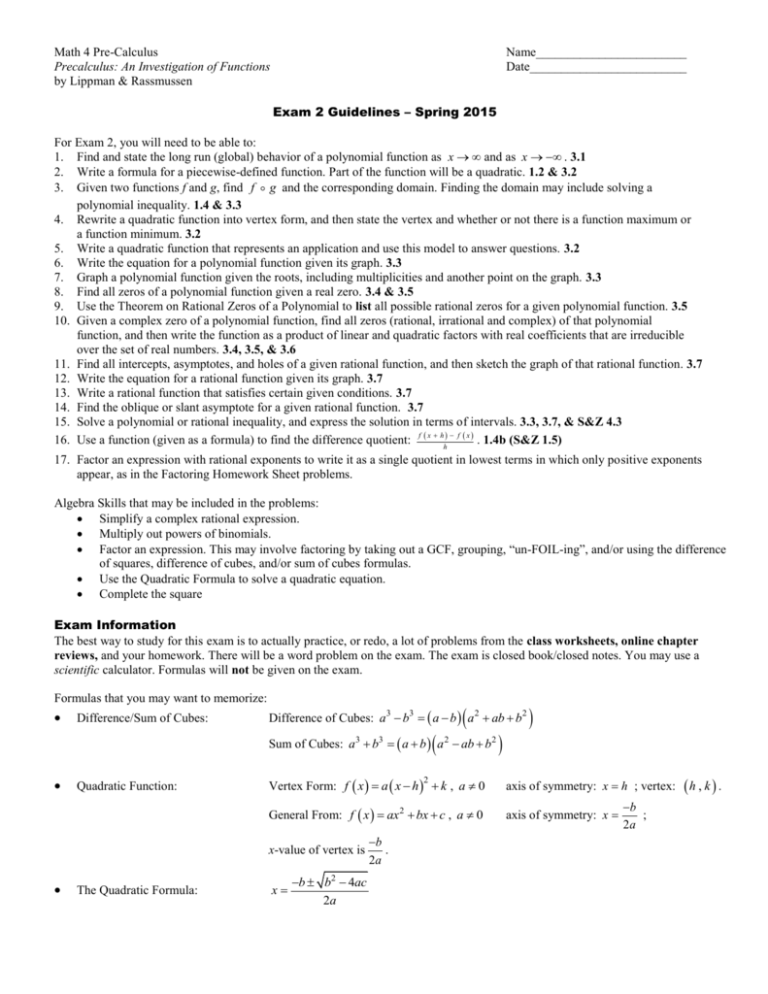
Math 4 Pre-Calculus Precalculus: An Investigation of Functions by Lippman & Rassmussen Name________________________ Date_________________________ Exam 2 Guidelines – Spring 2015 For Exam 2, you will need to be able to: 1. Find and state the long run (global) behavior of a polynomial function as x and as x . 3.1 2. Write a formula for a piecewise-defined function. Part of the function will be a quadratic. 1.2 & 3.2 3. Given two functions f and g, find f g and the corresponding domain. Finding the domain may include solving a polynomial inequality. 1.4 & 3.3 4. Rewrite a quadratic function into vertex form, and then state the vertex and whether or not there is a function maximum or a function minimum. 3.2 5. Write a quadratic function that represents an application and use this model to answer questions. 3.2 6. Write the equation for a polynomial function given its graph. 3.3 7. Graph a polynomial function given the roots, including multiplicities and another point on the graph. 3.3 8. Find all zeros of a polynomial function given a real zero. 3.4 & 3.5 9. Use the Theorem on Rational Zeros of a Polynomial to list all possible rational zeros for a given polynomial function. 3.5 10. Given a complex zero of a polynomial function, find all zeros (rational, irrational and complex) of that polynomial function, and then write the function as a product of linear and quadratic factors with real coefficients that are irreducible over the set of real numbers. 3.4, 3.5, & 3.6 11. Find all intercepts, asymptotes, and holes of a given rational function, and then sketch the graph of that rational function. 3.7 12. Write the equation for a rational function given its graph. 3.7 13. Write a rational function that satisfies certain given conditions. 3.7 14. Find the oblique or slant asymptote for a given rational function. 3.7 15. Solve a polynomial or rational inequality, and express the solution in terms of intervals. 3.3, 3.7, & S&Z 4.3 16. Use a function (given as a formula) to find the difference quotient: f x hh f x . 1.4b (S&Z 1.5) 17. Factor an expression with rational exponents to write it as a single quotient in lowest terms in which only positive exponents appear, as in the Factoring Homework Sheet problems. Algebra Skills that may be included in the problems: Simplify a complex rational expression. Multiply out powers of binomials. Factor an expression. This may involve factoring by taking out a GCF, grouping, “un-FOIL-ing”, and/or using the difference of squares, difference of cubes, and/or sum of cubes formulas. Use the Quadratic Formula to solve a quadratic equation. Complete the square Exam Information The best way to study for this exam is to actually practice, or redo, a lot of problems from the class worksheets, online chapter reviews, and your homework. There will be a word problem on the exam. The exam is closed book/closed notes. You may use a scientific calculator. Formulas will not be given on the exam. Formulas that you may want to memorize: Difference/Sum of Cubes: Difference of Cubes: a3 b3 a b a 2 ab b2 Sum of Cubes: a3 b3 a b a 2 ab b2 Quadratic Function: Vertex Form: f x a x h k , a 0 axis of symmetry: x h ; vertex: General From: f x ax 2 bx c , a 0 axis of symmetry: x 2 x-value of vertex is The Quadratic Formula: x b b2 4ac 2a b . 2a b ; 2a h , k . Important Topics f x an x n an 1 x n 1 ... a1 x a0 , determine end behavior by the degree and leading coefficient, find roots using various techniques (factoring, long division, synthetic division, Rational Root Theorem, complex conjugate pairs), and use the multiplicity of each root to determine the behavior at each x-intercept. Polynomial Functions: Rational Functions: Polynomial/Rational Inequalities and determining domains of functions containing square roots: Get one side equal to zero, factor, and then use a sign chart to determine the solution. f x an x n an 1 x n 1 ... a1 x a0 , bm x m bm 1 x m 1 ... b1 x b0 Vertical asymptotes occur at zeros of the denominator that are not zeros of the numerator, Holes occur when a factor can be cancelled and no longer appears in the denominator, X-intercepts occur at zeros of the numerator (that aren’t holes), Long run (global/end) behavior is determined by comparing the degree of the numerator and degree of the denominator: --Bigger Degree in the denominator: horizontal asymptote at y = 0 --Same Degree: horizontal asymptote at y = the ratio of the leading coefficients --Bigger Degree in the numerator: find the oblique asymptote by dividing Page 2 of 2

